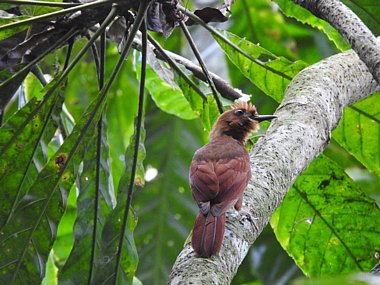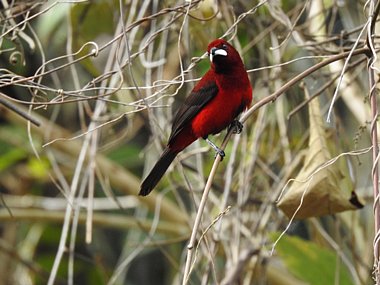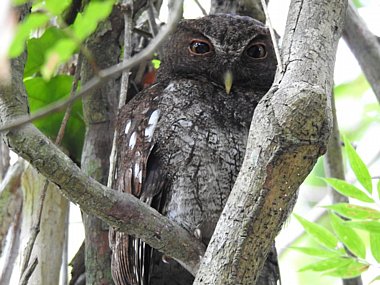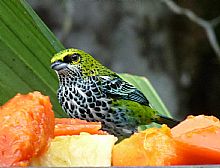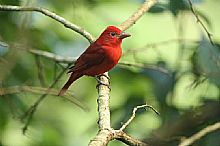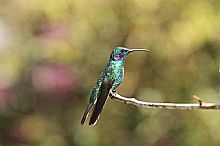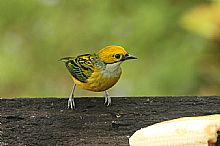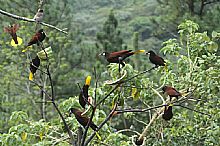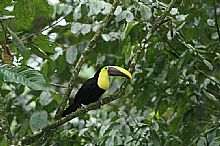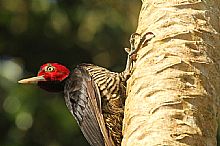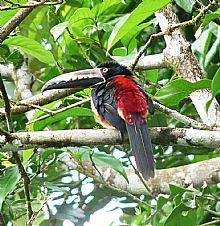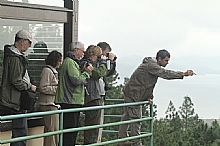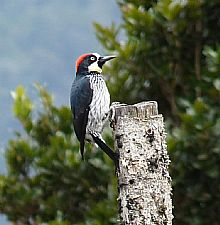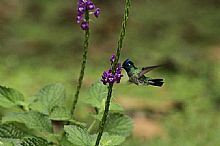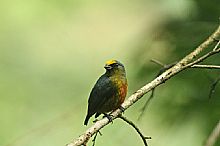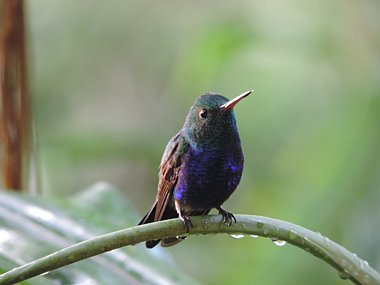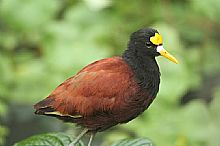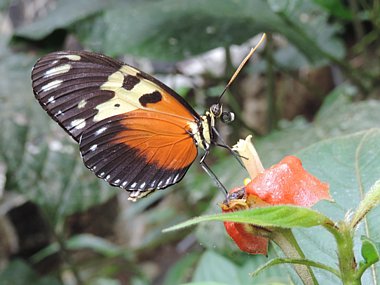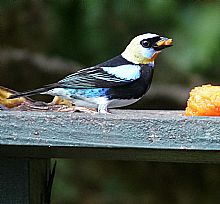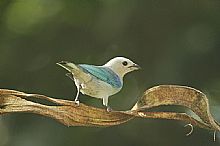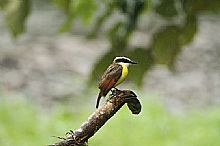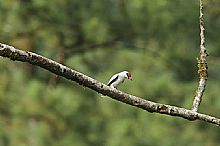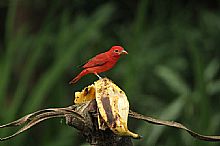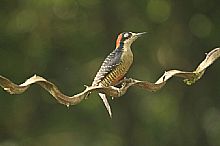NEW! Panama
Brilliant birding across Panama including the Pacific Slope and Tranquilo Bay
| Destinations | |
|---|---|
| Focus | |
| 2024 Dates | |
| Duration | 16 Days |
| Guides | |
| 2024 Price | £6295 pp £1295 single supplement. Deposit £1200. Join Heatherlea favourite Paco Madrigal and Panama expert Euclides "Kilo" Campos for this tour!. pre-flight airport hotel and lounge are inc. |
With its stunning Caribbean and Pacific coasts and broad variety of habitats, Panama is a popular birding destination for good reason. At the cross-roads between Central and South America, it holds almost 10% of world’s bird species. This carefully selected two centre itinerary covers central and western Panama to maximise superb birding opportunities and provide great variety.
The first week is focussed around central Panama, and we stay at Summit Hill Rainforest Resort, a good quality Hotel well used to birdwatching tours. We bird on the Pacific slope along the famous Pipeline Road, and visit the Rainforest Discovery Center and Observation Tower. Amongst hundreds of species, some of our targets include beautiful Blue Cotinga, Great Potoo, Streaked-chested Antpitta, Black-breasted Puffbird, Great Jacamar and with a little luck Hoffman's Two-toed Sloth and prehaps Harpy Eagle. From there we head to the Metropolitan Nature Park, Plantation Road and Summit ponds where Common Potoo, Rosy-thrush Tanager, Blue-crowned Manakin, Capped Heron and Spectacled Owl may be found. Moving on to Cerro Azul and Cerro Jefe we look for specialities such as Stripe-cheeked Woodpecker, Violet-capped Hummingbird, Rufous-crested Coquette, Hepatic Tanager and Red-capped Manakin. After this we will re-join the Pipeline Road, a brilliant birding hotspot, and look for species such as Great Tinamou, Black-striped Woodcreeper, Tiny Hawk, Rufous Motmot and Black-faced Ant-thrush. Our final first week destination is Semaphore Hill and the Ammo Dump where we search for Spotted Antbird, Fasciated Antshrike, White-flanked Antwren and Bicolored Antbird in the lush tropical rainforest.
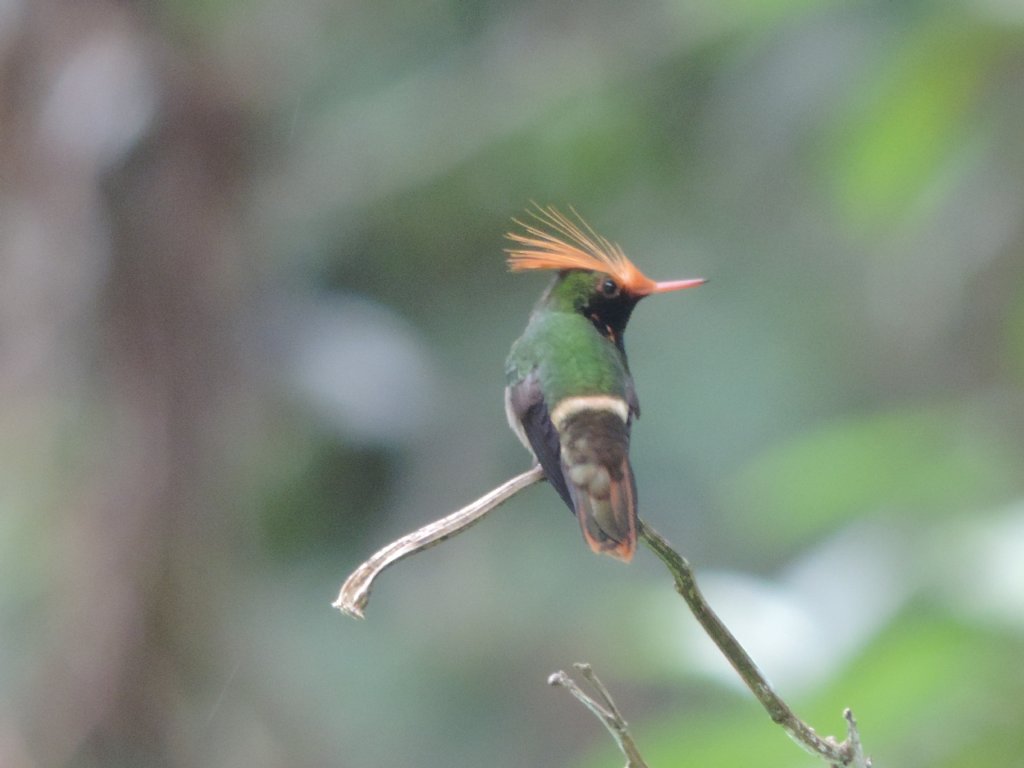
With thanks to Heatherlea client Pauline Chapman
For our second week we fly to Tranquilo Bay Eco-lodge on the western Caribbean slope, adjacent to Bastimentos National Marine Park. Our family-run lodge is located at the convergence of three distinct ecosystems, creating an extremely diverse and brilliant centre for birding on foot and by boat. Tranquilo Bay is on the Western Caribbean Slope and birding is quite different from the previous week. Some of our target bird species at Tranquilo Bay include Snowy Cotinga, Nicaraguan Seed-Finch, Red-billed Tropicbird, Lattice-tailed Trogon, Golden-browed Chlorophonia, Blue-and-Gold, Spangle-cheeked, and Emerald Tanagers, to name a few. The range of elevation and habitats near the lodge is impressive, allowing for a very diverse set of flora and fauna. Birding the Tranquilo Bay Eco-lodge trails and canopy tower is simply superb, with a dozen species of hummingbird recorded, six species of kingfisher, and many Northern American passage and wintering species including up to 25 species of wood warbler.
OUTLINE ITINERARY
Enjoy your complimentary pre-flight overnight hotel before your holiday begins. Full details from our office! Read more about our Pre-flight Service here!
Day 1: Sat 23 November 2024 Arrive to Panama City
After relaxing in our complimentary VIP Airport Lounge, we fly from London via a European hub to Tocumen International airport, where we will be warmly welcomed by Paco and escorted to our accommodation in the Summit Hill Resort, where we stay for the next seven nights.
Days 2 and 3: Sun 24 and Mon 25 November Pipeline Road, Panama Rainforest Discovery Center and Observation Tower
We spend two full days exploring Pipeline Road and the surrounding areas. This is a hotspot of Panamanian birding where we can see an impressive variety of forest birds over a 17k stretch of road. Pipeline Road runs through the famous Soberania National Park where we have the opportunity to explore deeper into the forest on several side-trails. Some of the highlights of this area include Olivaceous Flatbill, Black-tailed Trogon, White-tailed Trogon, Crimson Crested Woodpecker, Western Slaty Antshrike, Checker-throated Antwren, Bicolored Antbird, Red capped Manakin, Blue crowned Manakin and of course we also hope to find rarities including Rufous-vented Ground Cuckoo, Pheasant Cuckoo and Great Jacamar to mention a few. There’s no shortage of raptors here! We will be looking for all three species of Forest Falcon, Great Black Hawk, White Hawk, Barred Hawk, Plumbeous Hawk and if we are lucky maybe even Harpy Eagle. This superb area, full of avian riches, really does deserve two days to fully explore its birding potential.
One day we visit the Panama Rainforest Discovery Center from Pipeline Road. We will enjoy the unique above-canopy vantage point by climbing the 32- metre tall Observation Tower. Views of the vast forest from the tower are simply spectacular; from this vantage point you can see ships on the Panama Canal, the majestic Centennial Bridge, and miles of rainforest! From here, you get a unique eye-level perspective of the rainforest canopy. Many birds, including toucans, parrots, tanagers of various types, hawks and more are seen. The hummingbird feeders at the base of the Tower are good for Long-billed Hermit, White-Necked Jacobin, Violet-bellied and Blue-chested Hummingbirds and White-vented Plumeleteer. Occasionally, a Snowy-bellied Hummingbird is spotted. We will be looking out for Black Breasted Puffbird, Pied Puffbird, Great Black Hawk and the special of the day, Blue Cotinga.
Day 4: Tue 26 November Metropolitan Nature Park
Today, right after breakfast, we visit Metropolitan Park. Despite its location inside the city, this incredible park offers an amazing variety of birds and other animals. The forests here are considerably drier than the habitats we have seen thus far, providing a new array of species. A few common birds are Lance-tailed Manakin, White-bellied Antbird, Western Slaty Antshrike, Forest Elaenia, Southern Bentbill, Rosy Thrush-Tanager, Short-tailed Swift, Yellow-crowned Amazon, Common Potoo and Yellow-rumped Cacique. We also look for Rufous-brested and Rufous-and-white Wren, Cocoa and Olivaceous Woodcreeper, White-necked Puffbird, Crimson-backed Tanager, Golden-fronted Greenlet, Lineated Woodpecker, Southern Beardless Tyrannulet, and the harder to find endemic Yellow-green Tyrannulet. This is also a great place to see mammals, including Coatimundi, Three-toed Sloth and Geoffrey’s Tamarin.
Day 5: Wed 27 November Cerro Azul & Cerro Jefe
After breakfast we travel up to the cool foothills of Cerro Azul (2500 ft in elevation) and Cerro Jefe (3,300 ft in elevation) where we will be dazzled by an array of magnificent birds including Emerald, Speckled, Rufous-winged, Golden-hooded, Silver-throated, Bay headed, Hepatic, Olive and Black-and-yellow Tanager. A few other target species include majestic Ornate Hawk-Eagle, Spot-crowned Barbet, Scale-crested Pygmy-Tyrant, and endemic Stripe-cheeked Woodpecker and if we are really lucky near-endemic Tacarcuna Bush-tanager. This is part of the most important protected area vital to the health of the Panama Canal watershed, preserved within the Chagres National Park.
Day 6: Thur 28 November Semaphore Hill and Ammo Dump
Semaphore Hill is a jungle-lined road winding down another nearby section of the Soberania National Park. In this habitat we look for more forest birds including Slaty Antwren, White-flanked Anwren, Fasciated Antshrike, Marbled Wood-Quail, Great Tinamou, Rufous Motmot and many others. This is a great place to look for antbirds as army ant swarms are a common occurrence, and gorgeous Ocellated Antbird, Spotted Antbird and Bicolored Antbird follow the insects. There are lots of mammals here and in the surrounding Central Panama region, including Brown-throated Three-toed Sloth, Hoffman's Two-toed Sloth, Coatimundi, Mantled Howler Monkey, White-faced Capuchin, Geoffroy's Tamarin, Capybara, Kinkajou, and Northern Tamandua.
Later in the day we visit the pond at Ammo Dump, a fantastic spot to see water birds. A few of our targets will be Least Grebe, Purple Gallinule, Common Moorhen, Striated Heron, and hard-to-find Capped Heron. This is also the best place to find White-throated Crake, and Least Bittern, Rufescent Tiger-Heron and American Pygmy Kingfisher are also resident. Here we should also find Olivaceous Piculet, Yellow-tailed Oriole, Southern Lapwing, Yellow-crowned Tyrannulet, Scrub Greenlet and Panama, Social and Rusty-margined Flycatchers among others, in the surrounding trees and marshy fields. Hook-billed and Snail Kites, Collared Forest-Falcon, Yellow-headed Caracara, Zone-tailed and Short-tailed Hawks are here sometimes too!
Day 7: Fri 29 November Plantation Road, Summit Ponds and Old Gamboa Road.
Today we explore another incredible section of the Canal Corridor region. A mix of secondary forest, open areas, gardens, and patches of dry forest, scrub, grasslands, river banks and natural ponds provide a great day of birding. Plantation Road runs through an old growth forest and areas of secondary forest on the north side of the Continental divide. Much of the trees are tall and have very little forest undergrowth, making spotting forest floor species like tinamous and leaf tossers unusually easy. Here we also hope to see Southern Bentbill, Golden-crowned Spadebill, Slaty-tailed Trogon, Blue-crowned Motmot, Buff-rumped Warbler, White-breasted Wood-wren, a variety of antbirds, Gray-headed Tanager, and Plain-Brown and Northern-barred Woodpecker among many others. Next we visit Summit Ponds and finally Old Gamoa Road. As well as nesting Boat-billed Herons, we look for Striated, Green and possibly Capped Heron, as well as Wattled Jacana. This is also a great place to see kingfishers; all six species in the Americas have been seen. We finish our rewarding day of birding at a true hot spot, Old Gamboa Road. The diversity of habitats featured here yield an incredible variety of birdlife including Jet Antbird, Great Antshrike, Rosy Thrush-Tanager, Lance-tailed and Golden-collared Manakin, Black-tailed and Royal Flycatcher, Lesser and Great Kiskadee, Buff breasted Wren and Rusty Margined Flycatcher.
Day 8: Sat 30 November Transfer to Tranquilo Bay and initial birding
Today we make the transfer to Tranquilo Bay by air to Bocas del Toro (approximately 1 hour flight) where we take a boat to Tranquilo Bay (approx. 40 minutes). We stay for six nights at the unforgettable Bocas del Toro Eco Resort.
After we have settled in, we enter the forest trail in search of Chestnut-backed Antbird, White-flanked and Dot-winged Antwren, Black-crowned Antshrike, Red-throated Ant-Tanager, Tawny-crested Tanager, Rufescent Tiger-Heron, and the geographically misplaced Stub-tailed Spadebill. After a short hike we arrive at Pineapple Hill, a small elevated clearing at the forest’s edge, which is an important forage area for a multitude of neotropical and migratory species. This is an excellent place to see feeding birds such as Golden-collared and Red-Capped Manakin, three species of honeycreeper, Passerini’s, Scarlet, White-lined, and Summer Tanager, Baltimore Oriole, Band-tailed Barbthroat, Green-breasted Mango, White-necked Jacobin and Purple-crowned Fairy hummingbirds, Scaled Pigeon, Double-toothed Kite, Roadside Hawk and the hard to see White-throated Crake. Another forest trail takes us to a Golden-collared Manakin lek. During the mating season, from December - August, each lek should have displaying males. Further along this trail is an area of high forest canopy, where Three-wattled Bellbirds like to spend midday. This canopy specialist likes to perch underneath the leaves in the shade, presenting an opportunity for photographers. On the way back to the lodge, we search the forest floor for the famous Isla Bastimentos Red Poison Dart Frog. This morph of Oophaga pumilio is studied onsite by the Smithsonian Tropical Research Institute who are researching its evolutionary traits.
After a break, we focus our efforts in the mangrove forest looking for several species of heron, Green Ibis, Mangrove Black Hawk, five kingfisher species, Mangrove Cuckoo, Whimbrel, Willet, Prothonotary Warbler and resident Mangrove Warbler, whose males exhibit a stunning red hood. In the evening we climb the canopy tower to watch from a bird’s-eye view the pandemonium of Red-lored and Mealy Parrots paired up and returning home, as groups of chattering Blue-headed Parrot join the chorus. We also may have close views of White-crowned and Scaled Pigeon, Black-crowned and Masked Tityra, Lineated and Black-cheeked Woodpecker, Blue-grey, Palm, and Plain-colored Tanager, White-vented Euphonia, and scores of flycatchers.
Day 9: Sun 1 December Palo Seco Protection Forest
After a delicious Panamanian breakfast, we leave the dock at 6am and travel by boat to the town of Punta Robalo on the mainland. Today we will be birding in the Palo Seco Protection Forest, one of the most vital areas of La Amistad Biosphere Reserve. This incredible area consists of wet Atlantic forest, foothills, and watersheds, part of BirdLife International Endemic Bird Area Central American Caribbean Slope, EBA019. This is a hotbed for restricted range species, and is one of the most important protected areas in the Neotropics. Snowy Cotinga, Chestnut-colored and Cinnamon Woodpecker, Rufous-tailed Jacamar, Crimson-colored, Speckled, Emerald, and Silver-throated Tanager, Lattice-tailed Trogon, Bronze-tailed Plumeleteer, Green Hermit, Slaty Spinetail, Dull-mantled Antbird, and Band-backed and Black-throated Wren are all possible. We also make every effort to see elusive Lanceolated Monklet.
Other lowland specialties might include Brown Jay, White-crowned Parrot, White-collared Seedeater, Olive-crowned Yellowthroat, Cinnamon and White-winged Becard, Long-billed Gnatwren, Wedge-billed Woodcreeper, Black-and-Yellow Tanager, Buff-rumped Warbler, Torrent Tyrranulet, Crimson-fronted Parakeet, and Red-fronted Parrotlet.
Mammal sightings in the area might include sloths, Mantled Howler Monkey, Red-brocket Deer, squirrels and several species of bats. In the late afternoon we will work our way back through the lowland foothills scanning for kettles of raptors, Snowy and Blue Cotinga, and marsh birds including various sandpipers, three species of ibis, Southern Lapwing, Blue-winged Teal, Black-bellied Whistling-Duck, and Common Gallinule. A fresh picnic lunch will be served in the field and we return to the lodge in the evening.
Day 10: Mon 2 December Fortuna Forest Reserve
The Continental Divide of the Talamanca Range, between the provinces of Bocas del Toro and Chiriqui, is one of Panama’s premier birding and wilderness areas. Today we will focus on the area known as Umbrellabird Road, between the Continental Divide and north of Fortuna Reservoir. This is the best area to find Umbrellabirds between the months of March-September, which is considered the breeding season. Fortuna Forest Reserve, established in 1976, is a species-rich area and part of BirdLife International Endemic Bird Area Costa Rica and Panama Highlands, EBA 020. The distinct avifauna in this globally important area include many regional endemics and restricted range species. Our visit here is sure to produce outstanding birds, with opportunities to see Black-headed Nightingale-Thrush, Red-faced Spinetail, Ashy-throated Bush-Tanager, Golden-browed Chlorophonia, Black and Crested Guan, Blue-and-Gold Tanager, Black-thighed and Black-faced Grosbeak, and Golden-winged Warbler to mention a few. We enjoy a picnic lunch while overlooking the beautiful vistas of Lake Fortuna. Typical species highlights might include: Azure-hooded Jay, Sulphur-winged and Barred Parakeet, Bay-headed, Rufous-winged, Flame-colored, White-winged, Carmiol’s, Cherrie’s, Hepatic, and Spangled-cheeked Tanager, Slate-throated Redstart, Tropical Parula, Blue-and-White Swallow, Rufous-winged, Golden-olive and Smoky-brown Woodpecker, Elegant and Tawny-capped Euphonia, Slaty Flowerpiercer, Golden-bellied Flycatcher, and the gorgeous Orange-bellied Trogon. Several raptors are possible including Ornate Hawk-Eagle, Barred Hawk, Great Black-Hawk and Swallow-tailed Kite along with abundant kettles during the migration season. More possibilities worth mentioning include Blue-throated Toucanet, Red-headed and Prong-billed Barbet, White-crowned and White-ruffed Manakin, Broad-billed Motmot, Green-thorntail, Snowy-bellied, Stripe-tailed, and Rufous-crested Coquette and Black-bellied Hummingbird. The strange Tayra, a weasel-like Neotropical mammal with wrinkled facial skin, has been spotted in this area. A relaxing boat ride back to the lodge might produce Brown Booby, Black and American Royal Tern, Willet, Mangrove Swallow, and Bottlenose Dolphin among others. We will arrive at the lodge in the early evening where we discuss our lists and share the day’s best photos over appetizers and drinks on the veranda, followed by a tasty dinner.
Day 11: Tues 3 December Tranquilo Bay Canopy Observation Tower
Tranquilo Bay’s latest eco-adventure soars 100 ft above sea level, bringing you to the top of the forest canopy for a panoramic bird’s-eye view of three distinctly different ecosystems within Bastimentos Island National Marine Park. The bird watching, wildlife, and photo opportunities from this incredible vantage point are exceptional. During the day, as thermals start rising off of the Caribbean Sea, raptors will soar for hours. The tower is an excellent place to scan for Black Hawk-Eagle, Mangrove Black-Hawk, Bat, Laughing, and Peregrine Falcons, Double-toothed Kite and White Hawk.
Beautiful regional endemic Snowy Cotinga can be seen from the tower along with large groups of Montezuma's Oropendola, hordes of parrots, Olive-throated Parakeet, White-crowned and Scaled Pigeon, Blue Dacnis, three species of honeycreeper, Tropical Gnatcatcher, Three-wattled Bellbird, Osprey, several species of hummingbird, Lineated and Black-cheeked Woodpecker, Magnificent Frigatebird, Brown Pelican, multiple swifts and swallows, Common and Lesser Nighthawk, tanagers, euphonias, and many flycatchers. Many species of mammals and reptiles found at the lodge can also be seen from the tower, as can butterflies, moths and other beautiful insects. Marine species such as dolphins and sea turtles are also possibilities, as we look out over the coral reefs of the Caribbean Sea. A good sunset should not be missed. From the tower’s vantage, as the sun sets on Tranquilo Bay, surreal hues of indigo, lavender, and orange paint the western sky over the surrounding forest and stunning Talamanca Range.
Day 12: Wed 4 December San San Pond Sak Wetlands/Snyder Canal
Today will be a tranquil day of “birding by boat” within several lush, coastal, wetland habitats. San San Pond Sak Wetlands is a designated Ramsar site, as well as, part of the La Amistad UNESCO Biosphere Reserve. The area is rich with abundant habitats including Atlantic wet lowland forest, Raphia palm swamp, fresh water river course, ocean impact beachfront, and mangroves. Access to this verdant wildlife area will be via boat through the historic Snyder Canal, as birds conveniently fly through the gallery forest back and forth across the waterway.
Panama’s first canal was vital in establishing The United Fruit Company, and the very beginnings of what would become “The Banana Republic”. This is an excellent place to find many lowland bird species, northern and altitudinal migrants, raptors and shorebirds. All six species of kingfishers known to the Americas can be found here and we watch closely for regional endemics like diminutively distributed Nicaraguan Seed- Finch, White-collard Manakin (Almirante race), Olive-backed Euphonia, Black-cowled Oriole, Canebrake Wren, and Three-wattled Bellbird. Also possible are Masked Duck, Common Gallinule, Least Bittern, Pied-billed Grebe, Great Potoo, Northern Jacana and Bare-throated Tiger-Heron.
Raptor sightings might include Yellow-headed Caracara, Bat, Laughing and Peregrine Falcons, Osprey and Pearl Kite. From the high branches of fruiting trees down to the grassy and shrubby edge, we might find Passerini’s and Golden-hooded Tanager, Olive-crowned Yellowthroat, Red-breasted Blackbird, Buff-throated Saltator, Groove-billed Ani, Squirrel Cuckoo, chatters of Olive-throated Parakeet, Streaked and Scissor-tailed Flycatcher and the minute Common, Black-headed and Slate-headed Tody Flycatcher.
Mammal sightings might include Mantled Howler Monkey, Crab-eating Racoon, White-nosed Coati, Neotropical River Otter, West Indian Manatee and Bottlenose Dolphin. Soropta Beach, important for migrating and resident shorebirds, is also a nesting ground for Leatherback and Hawksbill sea turtles, in addition to Green Iguana, Basilisk Lizard, Common Boa Constrictor, Spectacled Caiman and American Crocodile. Here on the beach we enjoy a picnic lunch with fresh sea breeze and the shorebirds. This vibrant river mouth and beachfront might produce Parasitic and Pomarine Jaegers, Wilson’s, Collared, and Semipalmated Plover, Ruddy Turnstone, Sanderling, Least, Pectoral and Semipalmated Sandpiper, Common and Lesser Nighthawk, Lesser and Greater Yellowlegs, four species of tern and Roseate Spoonbill. In the afternoon, sea conditions permitting, we will pass two miles offshore to a breathtaking rookery and reserve known as Swan’s Caye, for beautiful close-up looks at Panama’s only known breeding colony of Red-billed Tropicbirds, as well as Brown Booby and Magnificent Frigatebird. We return to the lodge in the late afternoon.
Day 13: Thurs 5 December Isla Popa (birds and frogs)/ afternoon Tranquilo Bay
Each of the islands in the Bocas del Toro archipelago has interesting wildlife and high levels of endemism, however Isla Popa, the second largest island in the chain, has more species of birds and mammals due to its close proximity to the mainland. A leisurely boat ride of about two kilometers brings us to a dense gallery forest surrounded by rich mangrove lagoons. We bird this phenomenal area by boat, peacefully enjoying flights of Keel-billed and Black-Mandibled Toucan, Crimson-fronted Parakeet, Brown-hooded Parrot, Slaty-tailed Trogon, Golden-hooded Tanager, Plumbeus and Swallow-tailed Kite, Pale-billed and Lineated Woodpecker, Mangrove Cuckoo, Pygmy Kingfisher, and hopefully male Snowy Cotinga conspicuously blazing in the sun. This mangrove lagoon has some beautiful Turtle Sea Grass where we can have good views of sponges, starfish, urchins and Upside-down Jellyfish.
On one of the many forest trails at the lodge, a winding spring creek creates a favorite locale for resident hummingbirds to bathe. There are benches set up as viewing stations to comfortably observe and photograph this daily high-octane spectacle. Band-tailed Barbthroat, Purple-crowned Fairy, Crowned Woodnymph, and other hummingbirds fight ruthlessly for the best bathing positions. Once they get their turn at the fresh water, each species has its own dance-like preparations before taking its first splash. Red-capped Manakin, Prothonatary Warbler and Chestnut-backed Antbird might be found along the creek’s shallow edges.
There are various levels of activity throughout the day; however, the most consistent action can be observed in the evening time.
Day 14: Fri 6 December Depart Tranquilo Bay
We fly back to the international airport at Panama City, and stay overnight in a hotel near the airport. The following day (Day 15: Sat 7 December) we take our international flight via a European hub to London, where we arrive on the morning of Day 16: Sun 8 December.
Please note: all itineraries are given as a guide only. Actual holiday content may vary according to the judgement of your guide, and elements beyond our control (eg weather).
What's included in your holiday price:
- Scheduled return flights between London and Panama City, airport taxes, ground and boat transportation as outlined including all transportation in Panama, accommodation and all meals, including breakfast, lunch and dinner. Water is provided in the vehicle each day. Regional flights to and from Tranquilo Bay.
- The services of your leaders.
- Entrance fees to parks and reserves, and tips to hotels and restaurants.
- Departure taxes.
- The Heatherlea Pre-Flight Service offers everything you need at the airport, including hotels, car parking, airport lounges, regional flights, and upgrades. Let Heatherlea take the strain! Pre-flight airport hotel and lounge included subject to terms and conditions. Read more...
- Free Field Guide! - 'The Birds of Panama' by is included in your holiday price. One copy per room booked.
What's not included in your holiday price:
- Personal insurance, personal expenses including drinks ordered at the lodges, visa costs where necessary
- optional tips to the driver and local guide
- any other costs not specified as 'included'.
More holiday information:
Accommodation is in hotels or lodges with all rooms en suite. Some of the lodges are remote, and have simple-style rooms. All are spacious, have en-suite facilities, and are very comfortable to a good standard.
Food is usually served as a buffet, with a wide choice. Vegetarian and other diets are welcome.
Walking is generally light/moderate. There may be some uphill track and road walking, though generally an average level of fitness is required.
Weather will be mixed. Mostly the temperature will be warm, with the possibility of rain. In some locations the weather is hot and humid, in others hot and dry, and at altitude can be cool and wet.
Insects There are biting insects, though not usually as a major problem.
Group size is restricted to 12 clients maximum.
Flights are from London. We may be able to offer flight arrangements from another airport and/or or quote without flights so you can make your own arrangements. If you wish to add an extension either before or after your holiday, please contact us and we will be happy to arrange this for you.
Your Leaders:
Paco Madrigal
Paco is an exceptional Leader, and we are fortunate to secure his services. Paco was raised in the lowland rain forest of Sarapiqui, Costa Rica, and has over 30 years experience guiding both bird watching and natural history tours throughout Costa Rica and Panama. As a child, the rain forest was his backyard playground. He learned about the diverse local plants and animals from his father who had learned from his father. Paco became the first resident naturalist guide at the Selva Verde Lodge tropical reserve, and in 1989 was selected to participate in the first 4 month intensive training course for naturalist guides, sponsored by the World Wildlife Fund and the Organization for Tropical Studies.
Paco studied English and Ornithology at the University of Florida. Upon returning to Costa Rica, Paco worked for the renowned Organization for Tropical Studies (OTS) at La Selva Biological Station in Sarapiqui where he began to lead guided tours, and his personal enthusiasm to share his knowledge with visitors has led to a devoted following. We can tell you from extensive first-hand experience that Paco is extremely capable with wildlife, organisation and people.

Paco Madrigal
Euclides "Kilo" Campos
During the first week, we will also be enjoying the services of 'Kilo', a local Panamanian Guide. With "Kilo" it naturally feels like birding with a friend. He holds a Nature tourism degree from the National University of Panama, and has participated in numerous national and international bird projects such as Hawk Mountain Sanctuary in Pennsylvania (2005).
He speaks English fluently and loves showing the birds to visitors. Patient and attentive, he always receives high praise at the end of the trip. good at birdsong, 'Kilo' holds the record of seeing 778 Panama Birds in 2019.
Other birding and wildlife holidays in Central America & Caribbean
- Costa Rica Classic Tour
- Costa Rica Classic Tour - PLUS!
- Costa Rica with Easy Walking
- NEW! Belize - Wildlife of the Yucatan Peninsula
- NEW! Costa Rica Classic in November
- NEW! Costa Rica: Birding, Whales and wildlife during migration
- NEW! Cuba including Havana
- NEW! Guatemala
- NEW! Jamaica, Dominican Republic and Puerto Rico
- NEW! Mexico
- NEW! Tranquil Trinidad
- NEW! Trinidad, Tobago and Saint Lucia
Why choose Heatherlea for your birding and wildlife holiday in the Americas?
Our overseas holidays are planned with care to offer great birding and wildlife, led by capable Leaders who really look after you. Every holiday is run the 'Heatherlea Way', and we hope our Overseas Adventures remind you of the quality and care so many of you enjoy in Scotland. That means rewarding and exciting days in the field, and good quality accommodation and meals, with a real flavour of the country we are visiting. Heatherlea always seek to include the personal touches that make all the difference.
Heatherlea holidays are not ‘dawn to dusk’ expeditions. Our less-intensive approach is ideal for those who want to relax whilst experiencing the best wildlife watching, and wherever possible we organise early or late activity on an optional basis. We also take sensible breaks when in very hot places and regular comfort breaks on every holiday whenever possible. All itineraries are planned carefully around the best wildlife opportunities, and you won’t miss out on memorable wildlife, whilst enjoying relaxed, informal days that are great fun.
The really important part of any wildlife holiday is the experience for you, our valued customer. Heatherlea invest in many things to offer you the best possible service;
- We have been organising birding and wildlife holidays for over 30 seasons, and have a highly experienced and capable office team. We also offer a telephone and email service outside normal office hours.
- Heatherlea overseas holidays have a maximum of 12 clients per trip, putting the emphasis on personal service, and helping you get the best possible experience.
- Our holidays often include things which others might invite you to pay yourself, for instance Departure Taxes and tips to hotels.
- All elements of our holidays are sold under our own licence, ATOL 6113. Under ‘Flight-Plus’ legislation it is a legal requirement of any tour operator to hold an ATOL licence for the supply of any overseas holiday where a flight is involved, if that holiday includes either overseas accommodation and/or car hire. It can be a criminal offence for an operator to book flights as part of a package without an ATOL licence. Heatherlea also hold full Tour Operator Insurance for your added protection.
- Heatherlea is your complete wildlife holiday provider. Our ‘Back Office’ team can organise all your pre-flight and other travel needs. Our specialists will help you book the right services, at the best price. Book holiday extensions through us, and your ATOL protection is extended further. We don’t charge extra for this service.
- Heatherlea is a limited company, registered in Scotland, and registered to pay VAT (applies to all holidays within the European Union).





